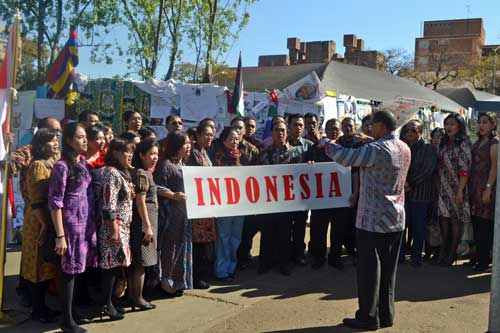

http://www.thediplomaticsociety.asia
Indonesia leaps into the future as a development model in Asia

The Nathania Ministry Choir from Indonesia pictured praying for Madiba in Pretoria on 6 August 2013. The Choir is on a tour in South Africa and will perform at various church services around the country.
By Srimal Fernando
Global Editor
Global Editor
Indonesia is one of the most vibrant and dynamic countries in Southeast Asia with more than 17,000 islands. It has a magnificent landscape endowed with beauty-spots, tranquil hill stations, mountains, long coastlines, and cloud-tickling skyscrapers, world-class hotels with devotional and historical places.
The country, being at the crossroads of many cultures, is a land of history, a place filled with the memory of many told and untold events. It is an incredibly crowded and densely packed country with an estimated population of 245million (Estimates 2012). The country enjoys historic ties with her neighboring East Asian countries and is a member of the Association of Southeast Asian Nations (ASEAN).
Indonesia is a highly secular nation that accommodates several religious communities. Islam forms the predominant religious group in the country. Jakarta, the capital city, needs little introduction among the thriving metropolis cities like Singapore, Kuala Lumpur and Ho Chi Minh City situated in Southeast Asia.
Jakarta has many characteristics of a world-class city. The city currently serves as the cooperate headquarters with many banking and financial institutions and multinational corporations, and contributes in significant proportion to the national Gross Domestic Production (GDP). Secondly the city has the political characteristics of hosting many international events. A large proportion of the population lives in Jakarta and the Jakarta metropolitan area. Jakarta MRT (Mass Rapid Transit) is a modern public transportation system network consisting of many lines with dozens of stations that provides various fast links between the city zone and the suburbs. In order to mitigate the traffic congestions in the country and to enhance the connectivity with other regions, Suramadu Bridge, the longest bridge in the country was constructed at a cost of US$ 450 million.
The urban landscape of Indonesia is changing at a rate faster than a decade ago. Various commercial and residential buildings and other infrastructure in the city create an open and pleasant environment for investment and further development. The country’s transport infrastructure is relatively advanced and is the backbone of the country. Having doubled in length in recent years the multi-lane expressways and rail links connect several major cities in Indonesia.
Jakarta International Airport, also called the Soekarno-Hatta International Airport, is one of the most important aviation hubs connecting Southeast Asia, the pacific and the rest of the globe. It is a stopover point for many international flights. With landing capability for larger aircrafts the Soekarno-Hatta International Airport has 42 gates with 150 check-in counters.
Tourism in Indonesia has been experiencing sustainable growth for the last three decades. It is emerging as a strong tourist destination. Today the daily lives have profoundly changed in the country, attracting millions of tourists annually. The noteworthy large islands such as Sumatra, Java, Irian- Jaya, Indonesian Borneo, Moluccas and Sulawesi needs little introduction to many visitors to the country.
Among the Southeast Asian nations Indonesia has been the water-shed in distribution of welfare and socio-economic development to the people of the country.
During the last 15 years there were marked improvements in the lives of the poor masses in Indonesia. The percentage of people living below the poverty line had decreased to 12.5 % in 2011 (ADB, 2011). Economic growth, development in education, health, and other infrastructure facilities, developing aid and micro financing are the contributing factors to reducing poverty in the country. According to the Asian Development Bank (ADB), Indonesia is recognized as a middle income country in the world with per capita Gross National Income (GNI) of US $ 2,940 in the year 2011.
The Industry, Services and Agriculture sectors are the nation’s engines of growth. The three sectors continue to employ a significant proportion of the labour force. The Indonesian Government considers the manufacturing sector to be an integral part of its plan to diversify the economy. High levels of investment played a significant role in the economy of the country. The country’s national and provincial Chambers of Commerce and Industry bring together many financial and commercial institutions, both Indonesian and foreign.
The growth achievement of the 16th largest economy in the world is remarkable and outstanding. Over the years successful planning, trade and government interventions in the country’s 34 provinces has accelerated the growth of the Gross Domestic Production (GDP). As one of the largest electricity producers in the World, Indonesia is expanding its power generation capacity with two 10,000 Mega watt electricity generation programs. The telecommunication sector in Indonesia is well developed with millions of cellular subscribers and broadband internet access.
Indonesia is also modern in every sense of the word with shopping centers with the largest retail shopping malls and different shops. The country has rapidly risen to become a global economic force to be reckoned with. Indonesia possesses strong development indicators and is often hailed as a model in South East Asia that unhesitatingly leaps into the future.

No comments:
Post a Comment